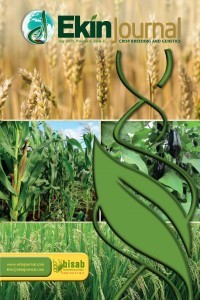Creating Varieties of The Perennial Cereal Grasses by The Polycross Method in Northern Kazakhstan
Creating Varieties of The Perennial Cereal Grasses by The Polycross Method in Northern Kazakhstan
wheatgrass, smooth brome, polycross method, clone, combining ability synthetic population,
___
- Dospehov BA (1985). Field experiments methodology. Moscow, Russian publishing house «Kolos», p. 351.
- Frandsen HN and Frandsen KI (1948). Polycross- methoden massekrydsnings-methode ved foraedling of fremmedbefrugtende planter. Nordisk Jordfruksforskning, pp: 239-261.
- Hаnson AA and Carnahan HL (1959). Breeding perennial forage grasses. Moscow, Russia. 2nd Ed, p. 182.
- Kedrov Zihman OO (1974). The polycross test in plant developing. Minsk, Belarus, p.128.
- Knowles RP (1955). Testing for the combining ability in bromegrass. Agron. J. 47, рр: 15-93.
- Kobylyansky VD, Katerova AG and Lapikov NS (1977). Guidelines for Heterosis developing rye using CMS. VIR, Russia, p. 28.
- Osipova GM (2006). Smooth brome. (Features of biology and developing in Siberia). Novosibirsk, Russia, p. 228.
- Shaepman H (1952). Application of the polycross tests to grass developing. Euphytica, рр: 105-111.
- Pflanzenzucht 42, рр: 11-24.
- Smurigyn MA, Novoselova AS and Konstantinova AM (1985). Guidelines for the selection of perennial grasses. Russian National Institute of Feed. Moscow, Russia, p. 188.
- Walther F (1959). Modellversuche zur Erzeugung synthetischer Heterosis beim Roggen. Z.
- ISSN: 2149-1275
- Yayın Aralığı: Yılda 2 Sayı
- Başlangıç: 2015
- Yayıncı: Bitki Islahçıları Alt Birliği
GGE Biplot Analysis of Multi-Environment Yield Trials in Barley (Hordeum vulgare L.) Cultivars
Ali Guendouz, Nadjim Semcheddine, Lyes Moumeni, Miloud Hafsi
Interrelationship Between 1000 Seed Weight with Other Quantitative Traits in Confectionary Sun ower
Nada Hladni, Siniša Jocić, Vladimir Miklič, Dragana MİLADİNOVİĆ, Miroslav ZORİĆ
Goksel Evci, Veli PEKCAN, İbrahim M. YİLMAZ, Nesrin CITAK, Nilüfer TUNA, Onur AY, Altug Pilaslı, Yalcin Kaya
Tomato Varieties with High Indices of Productivity and Resistance to Environmental Factors
Nadejda Mihnea, Vasile Botnari, Galina Lupascu
Vikender KAUR, Sunder SİNGH, Rishi Kumar BEHL
Heterotic Effects for Lint Yield in Double Cross Hybrids on Cotton
Remzi Ekinci, Sema Basbag, Oktay Gencer
Nikolay Tsenov, Dobrinka Atanasova, Todor Gubatov
Assessment of Drought Resistance in Indian Wheat Cultivars for Morpho-Physiological Traits
Renu Munjal, Satyavir Singh Dhanda
Syarifah Iis Aisya, Sri Wahyuni, Muhammad Syukur, Joko Ridho Witono
